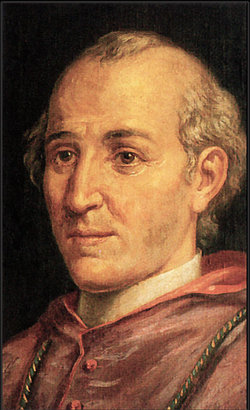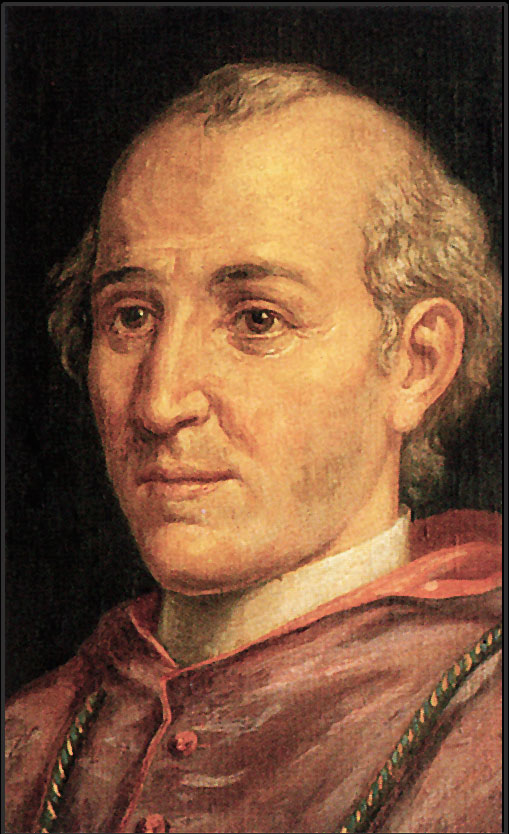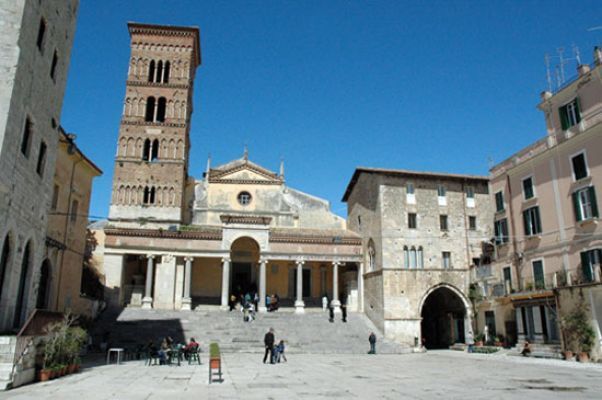Albertini was ordained to the priesthood at 22 years of age in 1793. On the occasion of the centenary of its donation, several groups joined in prayers in front of the relic of the Most Precious Blood on December 8, 1808, including a young Gaspare del Bufalo (1786 - 1837), to whom he assigned the panegyric for such an occasion. Noticing the great devotion people held towards this relic, Albertini decided to promote a group of priests honouring the Most Precious Blood, leaving in charge Gaspare, as no one else seemed so devoted and capable for such a post.
Successively, like Gaspare del Bufalo, Albertini refused to take oath in favour of Napoleon Bonaparte and thus were both condemned to exile. During this period, they worked hard to promote the devotion of the Most Precious Blood, with holy cards bearing a prayer for devotees being printed in thousands, including editions in foreign languages.
Back in Rome after four years of exile, Albertini and Gaspare kept on pursuing their noble projects. With the help of a high ranking prelate, Monsignor Belisario Cristaldi, Albertini obtained what he had long hoped for: Gaspare del Bufalo accepted to dedicate himself entirely for the realization of a nucleus of priests willing to promote the devotion of the Most Precious Blood through their homilies and spiritual exercises across the world.
The decisive moment finally arrived on August 15, 1815, when the Congregation of the Missionaries of the Most Precious Blood was initiated at San Felice di Grano. The Congregation was born officially on that day, but its roots date back to 1808, when Albertini decided to begin the project.
When Monsignor François-Xavier Pereira was named Bishop of Rieti, Albertini was appointed his successor as Bishop of the Diocese of Terracina, Priverno e Sezze on March 29, 1819, by Pope Pius VII, receiving his episcopal consecration from Cardinal Alessandro Mattei on the following April 18.
Immediately, Albertini worked hard for the promotion of the Congregation, organizing and participating in numerous "Missioni Popolari", across his diocese.
Unfortunately, his episcopate was short. After only six months from his episcopal consecration, Albertini died after a severe bout of malaria at the Bishops' Palace in Terracina on November 24, 1819, aged 49. He was succeeded in office by Msgr. Carlo Cavalieri Manassi.
With the death of Monsignor Albertini, Gaspare del Bufalo remained the sole heir to the Congregation. And with fellow member Bonanni named Bishop of Norcia, he remained its sole guide, by now called the Archconfraternity of the Most Precious Blood. The great dynamism of Gaspare, his deep predication, his persuasive methods, with himself being the protagonist of this mission of evangelisation, made the devotion to the Most Precious Blood - as predicted by Albertini - a mass movement. Don Gaspare was infact called by many as the "Spiritual Earthquake", and the "Tromba del Divin Sangue".
On Thursday, May 13, 2010, at 9.30 am., the canonical exhumation of the remains of Don Francesco Albertini took place at the Cathedral of Terracina. His pectoral cross was found among his remains, while his zucchetto could still be clearly seen attached to his head.
Don Albertini had a very important role in the foundations of the Congregation of the Most Precious Blood, more than anyone could ever think. The most convinced figure of this was Gaspare del Bufalo.
Albertini was ordained to the priesthood at 22 years of age in 1793. On the occasion of the centenary of its donation, several groups joined in prayers in front of the relic of the Most Precious Blood on December 8, 1808, including a young Gaspare del Bufalo (1786 - 1837), to whom he assigned the panegyric for such an occasion. Noticing the great devotion people held towards this relic, Albertini decided to promote a group of priests honouring the Most Precious Blood, leaving in charge Gaspare, as no one else seemed so devoted and capable for such a post.
Successively, like Gaspare del Bufalo, Albertini refused to take oath in favour of Napoleon Bonaparte and thus were both condemned to exile. During this period, they worked hard to promote the devotion of the Most Precious Blood, with holy cards bearing a prayer for devotees being printed in thousands, including editions in foreign languages.
Back in Rome after four years of exile, Albertini and Gaspare kept on pursuing their noble projects. With the help of a high ranking prelate, Monsignor Belisario Cristaldi, Albertini obtained what he had long hoped for: Gaspare del Bufalo accepted to dedicate himself entirely for the realization of a nucleus of priests willing to promote the devotion of the Most Precious Blood through their homilies and spiritual exercises across the world.
The decisive moment finally arrived on August 15, 1815, when the Congregation of the Missionaries of the Most Precious Blood was initiated at San Felice di Grano. The Congregation was born officially on that day, but its roots date back to 1808, when Albertini decided to begin the project.
When Monsignor François-Xavier Pereira was named Bishop of Rieti, Albertini was appointed his successor as Bishop of the Diocese of Terracina, Priverno e Sezze on March 29, 1819, by Pope Pius VII, receiving his episcopal consecration from Cardinal Alessandro Mattei on the following April 18.
Immediately, Albertini worked hard for the promotion of the Congregation, organizing and participating in numerous "Missioni Popolari", across his diocese.
Unfortunately, his episcopate was short. After only six months from his episcopal consecration, Albertini died after a severe bout of malaria at the Bishops' Palace in Terracina on November 24, 1819, aged 49. He was succeeded in office by Msgr. Carlo Cavalieri Manassi.
With the death of Monsignor Albertini, Gaspare del Bufalo remained the sole heir to the Congregation. And with fellow member Bonanni named Bishop of Norcia, he remained its sole guide, by now called the Archconfraternity of the Most Precious Blood. The great dynamism of Gaspare, his deep predication, his persuasive methods, with himself being the protagonist of this mission of evangelisation, made the devotion to the Most Precious Blood - as predicted by Albertini - a mass movement. Don Gaspare was infact called by many as the "Spiritual Earthquake", and the "Tromba del Divin Sangue".
On Thursday, May 13, 2010, at 9.30 am., the canonical exhumation of the remains of Don Francesco Albertini took place at the Cathedral of Terracina. His pectoral cross was found among his remains, while his zucchetto could still be clearly seen attached to his head.
Don Albertini had a very important role in the foundations of the Congregation of the Most Precious Blood, more than anyone could ever think. The most convinced figure of this was Gaspare del Bufalo.
Inscription
H(eic) S(itus) E(st)
Franciscus Albertinus
Domo Roma
Can(onicus) aed(ium) Nicol(ai) ad Carc(erem) Tullian(um)
rebus Curion(um) componendis
Et Clericis Proband(is) in Urbe Praep(ositus)
Conditor Sodalitatis
Cui a Christi Sanguine nomen est
Tenax propositi Relgi(ionis) Ergo
In Corsica ins(ula) Captiuvs exulavit
Inde redux
Ad Episcopat(us) Terracinen(sium) Setinor(um
Privern(ensium)
A Pio VII Pontifice Maximo evectus est
Vixit annos XXXXVIIII sanctissime
Decessit in pace VIII K(alendas) Dec(embris) anno
MDCCCXVIIII
Advertisement
Advertisement



